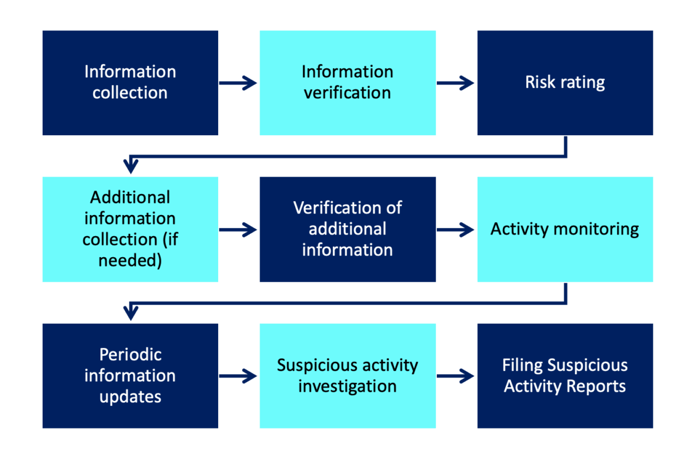Financial regulators across the world mandate institutions under them to properly assess their prospective customers before they open an account. This assessment is important because it prevents criminals from abusing financial systems for fraudulent and money laundering activities. CDD or Customer Due Diligence for banks and financial services helps verify the identity of customers and the nature of their business. Customer Due Diligence programmes are necessary for financial institutions to mitigate risk and Customer Due Diligence checks will help prevent them from doing business with risky customers.
In this article, we will look in detail at what CDD means, the importance of CDD in banking and how a financial institution can build an effective Customer Due Diligence programme.
What does CDD mean?
CDD is the process of evaluating your customers’ backgrounds to get an accurate picture of their profiles and identify their true risk level. This is accomplished by analysing a customer’s details such as name, official document photograph, address, occupation and nature of business. In addition, they are screened against certain checklists/watchlists for proper risk assessment.
CDD is an essential part of a financial institution’s Anti-Money Laundering (AML) and Know Your Customer (KYC) compliance programmes. It would ultimately prevent financial crimes like money laundering, terrorist financing, human trafficking and drug trafficking.
Why does a bank have CDD procedures?
When you examine the stakes, it becomes clear why banks and other financial institutions are investing so heavily in anti-money laundering compliance. These countermeasures are intended to combat the growing threat of money laundering, which is now employed by a wide spectrum of criminal enterprises.
There are many reasons why banks and financial services should take CDD seriously:
- Risk to a financial institution’s reputation: Financial crime incidents jeopardise a financial institution’s hard-earned reputation. Once lost, it takes a longer time to clear the tainted image.
- Large compliance penalties: AML enforcement actions have been on the rise. Regulators have collected more than $35 billion in AML-related fines worldwide since 2009.
- Sophisticated criminals: Today’s criminals are employing more complex methods to avoid detection, such as globally coordinated technology, insider knowledge, the dark web and e-commerce schemes.
- Increasing costs: Most AML compliance tasks require a lot of manual work, making them inefficient and difficult to scale. AML compliance costs $25.3 billion per year across U.S. financial service organisations, with some major financial institutions spending up to $500 million per year on KYC and customer due diligence.
- Poor service quality: To obtain and verify information, compliance workers must interact with customers at several points. One out of every three financial institutions have lost potential customers owing to inefficient or lengthy onboarding processes, which is unsurprising.
The importance of CDD in banking
Customer due diligence helps authenticate a client’s identification and the business in which they are involved to have enough trustworthiness. A variety of regulatory requirements are involved in the process:
- Customers must be identified by getting personal information from a trustworthy, independent source, such as their name, photo ID, address, and birth certificate.
- In cases where the customer is not the beneficial owner of a corporation, due diligence techniques should be used to identify beneficial ownership. Understanding the company’s control structure is important when determining beneficial ownership.
- Based on the identification of customers and beneficial owners, businesses must acquire insight into the nature and purpose of the commercial connection they are entering into.
What’s the difference between KYC and CDD?
Customer Due Diligence (CDD) is the process by which a company verifies the identification of its customers and assesses the risks associated with the business connection. KYC is all about proving that you’ve completed your CDD. A financial institution’s AML compliance process requires both KYC and CDD.
When Must Customer Due Diligence Checks Be Completed?
Customer Due Diligence is required when companies with AML processes enter a business relationship with a customer or a potential customer to assess their risk profile and verify their identity.
If a consumer is suspected of money laundering or financing terrorism, organisations are required to conduct CDD checks. Given below are some situations when financial institutions must take CDD checks:
- Occasional transactions: Certain rare transactions necessitate Customer due diligence. These could include large sums of money or entities located in high-risk foreign countries.
- New business relationship: Before establishing a commercial relationship, companies must conduct CDD to confirm that the customer matches their risk tolerance and is not using a false identity.
- Gaps in information: When clients give unreliable or inadequate identification documents, businesses should do additional CDD checks.
The FATF’s recommendation on CDD
According to the FATF, the following customer due diligence (CDD) measures are to be taken by an institution:
- Identifying the customer and verifying that customer’s identity using reliable, independent source documents, data or information.
- Identifying the beneficial owner, and taking reasonable measures to verify the identity of the beneficial owner such that the financial institution is satisfied that it knows who the beneficial owner is.
Obtaining information on the purpose and intended nature of the business relationship.
- Conducting ongoing due diligence on the business relationship and scrutiny of transactions undertaken throughout the course of that relationship to ensure that the transactions being conducted are consistent with the institution’s knowledge of the customer, their business and risk profile, including, where necessary, the source of funds.
What Is The Customer Due Diligence Process?
Given below is the process flow of customer due diligence.
- The basic CDD is used to collect information about the customer first. (Full name, contact information, birthplace and date, nationality, marital status, and so on).
- Scanning is used to authenticate in the event of a doubt.
- The activities of customers are scrutinised.
- For higher-risk customers and Politically Exposed Persons (PEPs), more thorough due diligence is required.
- As client profiles change, the continuing CDD Checks procedure continues.
- If a suspicious activity is detected, it is investigated thoroughly.
- If the investigation proves relevant, Suspicious Activity Reports (SARs) are filed.
Below is a graphic representation of the CDD process.

What Are The Types of Customer Due Diligence?
Depending on assessed risk, CDD measures should change.
- Standard Customer Due Diligence: This is a basic examination of a predetermined set of factors to assess the risk level of potential customers.
- Enhanced Due Diligence (EDD): Some consumers or business ties represent a greater risk of financial crime to businesses. The KYC process that allows higher-risk persons or corporations to be evaluated is known as Enhanced Due Diligence (EDD).
- Simplified Due Diligence: It is the opposite of enhanced due diligence and a lenient version of standard due diligence. It is implemented when the customer poses an extremely low risk for financial crimes.
- Ongoing Monitoring: While individual transactions may not appear suspicious at first, they may form part of a pattern of behaviour over time that indicates a change in a risk profile or business relationship. Ongoing monitoring helps a financial institution to reverify the information gathered during CDD. It also enables it to ask for explanations of red flags noticed.
CDD and modern technology
Successful CDD and KYC processes rely on a combination of technology and expertise. When risk profiles and criminal threats change, financial institutions must be as agile and creative in their approach to CDD as they are in any other aspect of their AML/CFT strategy. While technology can help with CDD processes, human awareness is still required to recognise and respond to emerging threats.
As regulators are becoming more stringent globally around AML compliance, strengthening the AML systems continues to remain among the top priorities. Tookitaki’s AML solution enables financial institutions to realise benefits with dynamic customer risk scoring, leveraging advanced machine learning models for improved effectiveness of Customer Due Diligence with fewer resources.
Request a demo to learn more about our AML solution and its unique features.
Anti-Financial Crime Compliance with Tookitaki?



